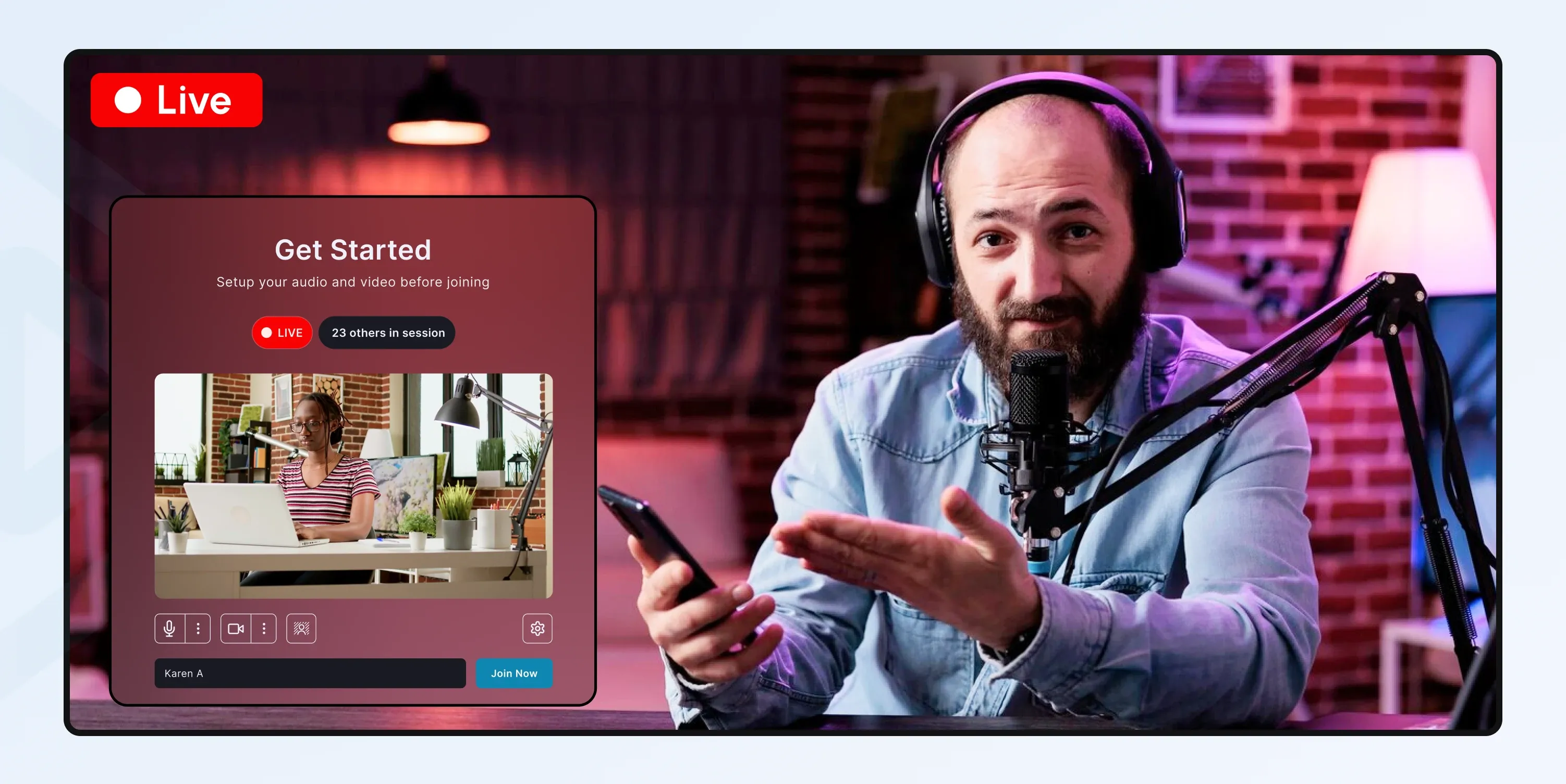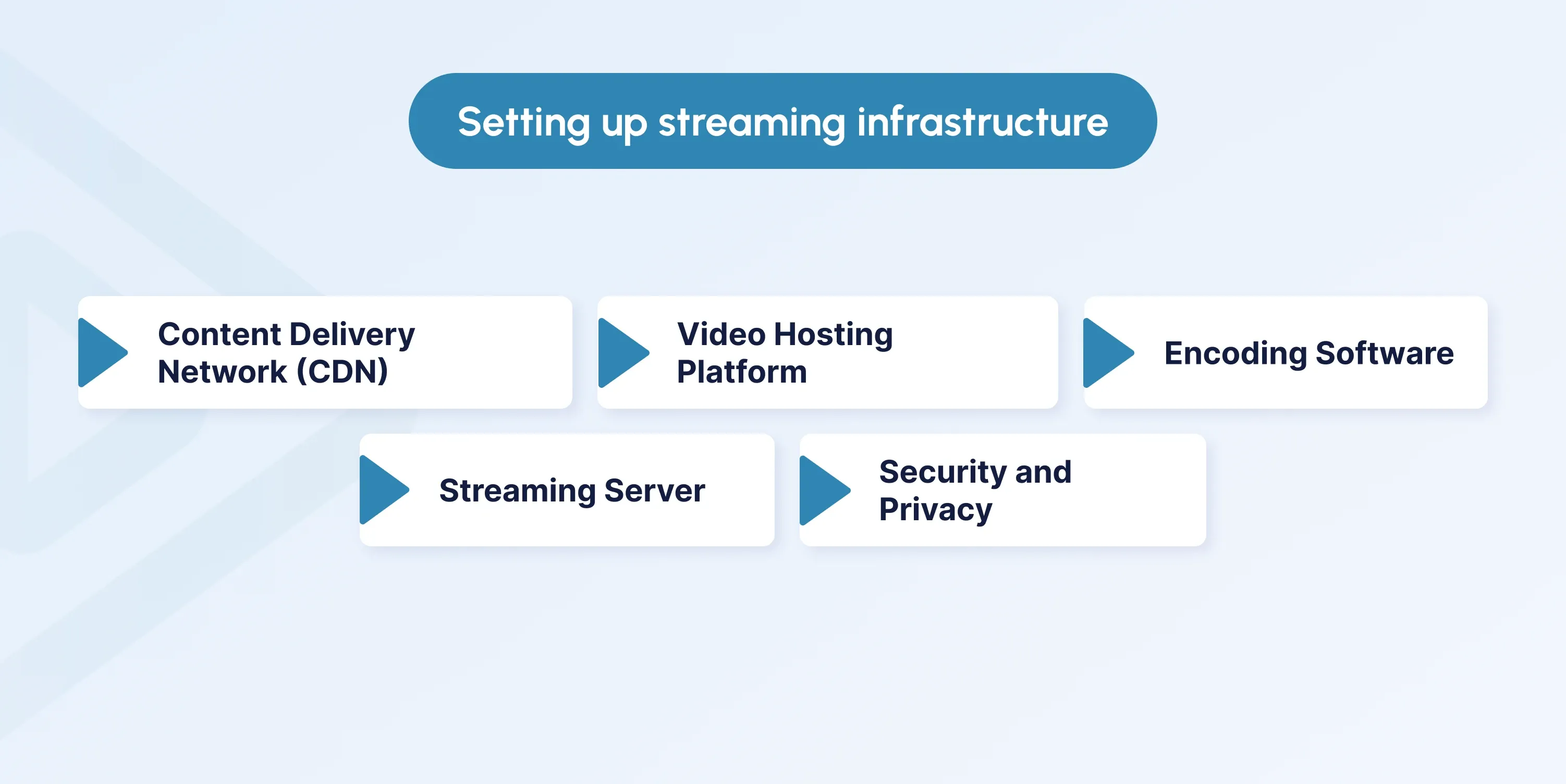
How to Create a Live Streaming Website? 2025 Guide
Having your streaming platform allows you to control your content, branding, and monetization strategies.
Launching a live streaming website enables direct interaction with your audience, whether broadcasting events, entertainment, or educational content.
In this guide, we’ll explain the key steps and considerations for creating a live streaming website tailored to your specific needs.
Key Takeaways
- Understand the basics of live streaming: Get familiar with essential tools, software, and reliable internet access to ensure a seamless streaming experience.
- Define your audience and goals: Identifying your target viewers, developing a strong content strategy, and setting clear objectives will help you create content that resonates.
- Plan for scalability and customization: Ensure your platform can grow with your needs, offering flexible customization options and opportunities to integrate monetization methods.
- Prioritize user experience: Focus on interactivity, easy navigation, and intuitive website design to keep your audience engaged and encourage return visits.
- Explore revenue streams: Consider pay-per-view, subscriptions, and ads to build a consistent income stream while delivering valuable content to your audience.
Understanding Live Streaming Basics
Live streaming allows viewers to engage with events in real time by delivering video content over the Internet as it happens.
To create a video streaming website that offers seamless and engaging streams, you'll need a camera, a stable internet connection, and encoding software to convert your video into a format fit for web streaming.
 Choosing the proper streaming protocol is crucial when creating a live streaming platform. HTTP Live Streaming (HLS) and Real-Time Messaging Protocol (RTMP) enable high-quality streams across various devices.
Choosing the proper streaming protocol is crucial when creating a live streaming platform. HTTP Live Streaming (HLS) and Real-Time Messaging Protocol (RTMP) enable high-quality streams across various devices.
Additionally, understanding the role of a content delivery network (CDN) is essential. A CDN minimizes buffering and latency, ensuring your stream reaches viewers without delay, no matter where they are.
Planning Your Live Streaming Website
The success of your live streaming website begins at the crucial planning stage. Whether your platform focuses on events, education, entertainment, or other live content, clearly define its primary objective.
Understanding your target audience is fundamental, as their preferences will shape your content strategy, user experience, and platform features.
Next, consider the website's technical requirements. Reliable hosting, fast servers, and the right video streaming technology ensure smooth, high-quality broadcasts.
Since your platform needs to handle multiple users simultaneously, scalability is also important when learning how to create a live streaming website. For paid or subscription-based services, allocate a budget for features like user accounts, live chat, and payment processing systems.
Monetization is another vital factor. Decide if you want to generate revenue through pay-per-view, subscriptions, or ads.
Additionally, create a clean, intuitive design that encourages user engagement and repeat visits. A well-designed platform ensures your live streaming service meets audience expectations and operates seamlessly.
Choosing the Right Technology for Your Live Streaming Website
You need the right technology to deliver your live streaming website a top-notch user experience and excellent streaming quality. The first critical decision is selecting a reliable streaming protocol.
RTMP (Real-Time Messaging Protocol) is ideal for low-latency streaming, while HLS (HTTP Live Streaming) offers greater flexibility, especially for mobile devices.
A good CDN is key to the smooth distribution of your broadcasts across multiple locations.
CDNs reduce latency and buffering by delivering content from the servers closest to your audience. This ensures uninterrupted playback regardless of where viewers are located.
A solid video encoding program is another vital component when creating a video streaming website. This software converts your live feed into formats suitable for various devices and bandwidths.
Top options with excellent live streaming encoding capabilities include vMix, Wirecast, and OBS Studio. Consider integrating a powerful video player that supports multiple formats and devices.
Security is also an important factor when learning how to create a live streaming platform. Encryption, digital rights management (DRM), and secure streaming protocols can protect your content and user data and prevent unauthorized access and piracy.
By carefully selecting the right technology, building a reliable and scalable streaming platform, and delivering a premium experience for your audience becomes much easier.
Developing the Website
From conception to launch, understanding how to create a live streaming website involves several key phases. The first step is selecting a robust content management system (CMS) that supports both live streaming and video hosting.
For example, WPStream plugins allow users to customize with PHP, while more specialized tools like Brightcove, Vimeo OTT, or inoRain OTT offer built-in live streaming platform features.
Once you've chosen your CMS, focus on designing a user-friendly interface. A simple, intuitive layout means visitors can easily navigate and access live broadcasts. Incorporate features like a content library or an organized event calendar to make it easy for users to find upcoming live streams.
Include interactive features like live chats, comment sections, and social media integration to skyrocket engagement.
These elements allow viewers to share their thoughts in real time, boosting user interaction. Optimizing your site for various screen sizes is another critical factor to consider when learning how to make a streaming website.
Since users will access your live streaming website on multiple devices, whether on desktop or mobile, your platform must be fully responsive to provide a seamless experience across all devices.
Streaming Infrastructure Setup
Wondering how to create a live streaming website that delivers high-quality, flawless broadcasts?
 Well, it involves selecting and configuring several key components that work together to provide seamless streaming experiences. Here’s a breakdown of the essential steps:
Well, it involves selecting and configuring several key components that work together to provide seamless streaming experiences. Here’s a breakdown of the essential steps:
Content Delivery Network (CDN)
A CDN is vital for sending live streams to a global audience without buffering or delays. CDNs store and deliver content from servers closest to viewers, ensuring quick and reliable playback.
Leading CDNs for live streaming include Amazon CloudFront, Cloudflare, and Akamai. Choose a CDN with low latency, strong scalability, and solid security features to support your live streaming platform needs.
Video Hosting Platform
A reliable video hosting platform is the backbone for managing and storing your live streams. Platforms like Brightcove, Vimeo OTT, and custom-built solutions like those from inoRain provide key features like transcoding, analytics, and multi-platform streaming.
These platforms are crucial when creating a video streaming website that handles live feeds smoothly.
Encoding Software
Encoding software converts your video into streaming-friendly formats. Popular encoding tools like OBS Studio and Wirecast compress video and adjust the quality based on available bandwidth.
Encoders ensure that your live broadcast delivers a consistent viewing experience across devices and internet speeds. Understanding this component is a crucial part of learning how to build a streaming platform.
Streaming Server
A dedicated streaming server, whether physical or cloud-based, is needed to host and distribute your stream to viewers.
Cloud-based solutions like Google Cloud and AWS Media Services offer scalability and ease of maintenance, making them ideal options for creating a streaming website that can grow with demand.
Security and Privacy
If you plan to make money from your streams, protecting your content from illegal access is absolutely fundamental. Secure your live streaming website with DRM, token-based authentication, or encryption.
It's also crucial to have monitoring tools in place to prevent and manage security threats like distributed denial-of-service (DDoS) attacks.
Improving User Experience
A successful live streaming website focuses on the user experience. Smooth and engaging interactions keep viewers hooked and encourage them to return. One of the first steps to achieving this is stream quality.
Offering high-definition (HD) video, 720p, 1080p, or even 4K, ensures your audience enjoys a crisp, clear picture.
Consider adaptive bitrate streaming (ABS), which automatically adjusts video quality based on the viewer's internet speed. This feature guarantees a smooth experience while minimizing buffering or interruptions.
Another key factor is reducing latency. For interactive content like sports, gaming, or Q&A sessions, minimizing the delay between live events and the broadcast is important.
Using low-latency streaming protocols such as WebRTC or low-latency HLS allows you to provide a near-real-time experience, keeping your viewers in sync with the action as it unfolds.
This kind of seamless delivery is essential whether you're figuring out how to create a live streaming platform or learning how to build one that captures and retains audience attention.
Monetizing Your Live Streaming Website
Monetization is key to ensuring the viability and financial success of your live streaming website or platform.
As a content creator or business owner, there are several effective ways to generate revenue depending on your content type and your audience. Each monetization strategy has its own advantages, so it's important to choose one that aligns with your goals and target market.
One popular method is the subscription-based model. Implementing tiered subscriptions allows you to offer different access levels, such as early content, premium features, or exclusive streams.
This strategy works particularly well for platforms focusing on niche content or regular live events. Subscription models encourage users to make ongoing payments, helping build a loyal audience and providing a steady income stream over time.
Another smart approach to monetization is leveraging advertising. You can incorporate ads into your live streams through pre-roll, mid-roll, and post-roll placements. This model works best when you're targeting a broad audience since advertisers are willing to pay more for increased exposure.
You can even consider sponsorship opportunities, where companies sponsor entire streams or events to further boost your revenue. Incorporating native ads or product placements into your content allows you to maximize income without disrupting the viewing experience.
Whether you're learning how to create a live streaming platform or starting a live streaming business, selecting the right monetization approach is crucial for long-term success.
Build a Live Streaming Platform With inoRain
 inoRain stands out as a top choice for businesses and content creators looking to start a live streaming service or improve their current platforms.
inoRain stands out as a top choice for businesses and content creators looking to start a live streaming service or improve their current platforms.
We provide a comprehensive set of tools tailored to meet modern streaming demands, offering a complete solution that supports growth and innovation. You can fully customize your live streaming service to match your unique needs and brand identity.
Whether you're a small business or a large enterprise, our tailored solutions allow you to create a distinctive streaming experience that captivates your audience.
From customizable features to user-friendly interfaces, our platform ensures that your streaming site aligns with your vision and meets your audience’s expectations.
inoRain offers the flexibility and tools you need to succeed when creating a live streaming website. Contact us to get started.
Conclusion
Now you know how to create a live streaming website!
By mastering the fundamentals of live streaming, carefully planning your strategy, and selecting the right equipment, you can build a successful platform that resonates with your viewers. Focusing on the user experience and choosing the right monetization strategies will help you maximize both engagement and revenue.
FAQs
What equipment do I need to start live streaming?
To begin live streaming, you'll need a high-quality camera, a good microphone for clear audio, and a reliable computer or streaming device. A stable internet connection is also crucial for continuous streaming.
Depending on your setup, you may also want to enhance your production quality with additional tools like streaming software, lighting equipment, and video capture cards.
How do I choose the right platform for live streaming?
When deciding how to create a live streaming platform, consider your target audience, budget, and required features.
Look for platforms that offer strong customer support, scalability, customization options, and monetization features.
Evaluating these aspects will help you choose a solution that aligns with your streaming goals and helps you build a successful platform.
Can I monetize my live streaming website?
Yes, you can make your live streaming website profitable through various methods, such as subscription models, pay-per-view options, and ad-based revenue.
Choosing a platform that supports multiple monetization strategies will help you generate income while offering valuable content to your audience.
Co-founder / CTO
Armen is the CTO and Co-Founder of inoRain OTT and Co-Founder of HotelSmarters, specializing in advanced streaming technologies, OTT strategy, and interactive TV systems. He builds scalable end-to-end video delivery solutions and drives technical innovation across hospitality and streaming platforms, bridging complex engineering with practical business impact.

How to Develop a Video Streaming App: Best Practices
Learn the basics of developing a modern video streaming app. This guide covers key best practices to help you build the right way from the start.

How to Make a Short Video App (2026 Complete Guide)
Learn how to build a short video app in 2026. Explore micro-drama trends, key features, monetization models, and step-by-step development insights.

OTT Advertising: Types, Best Practices, and Strategies
Over-the-top (OTT) advertising has transformed how brands connect with consumers.

